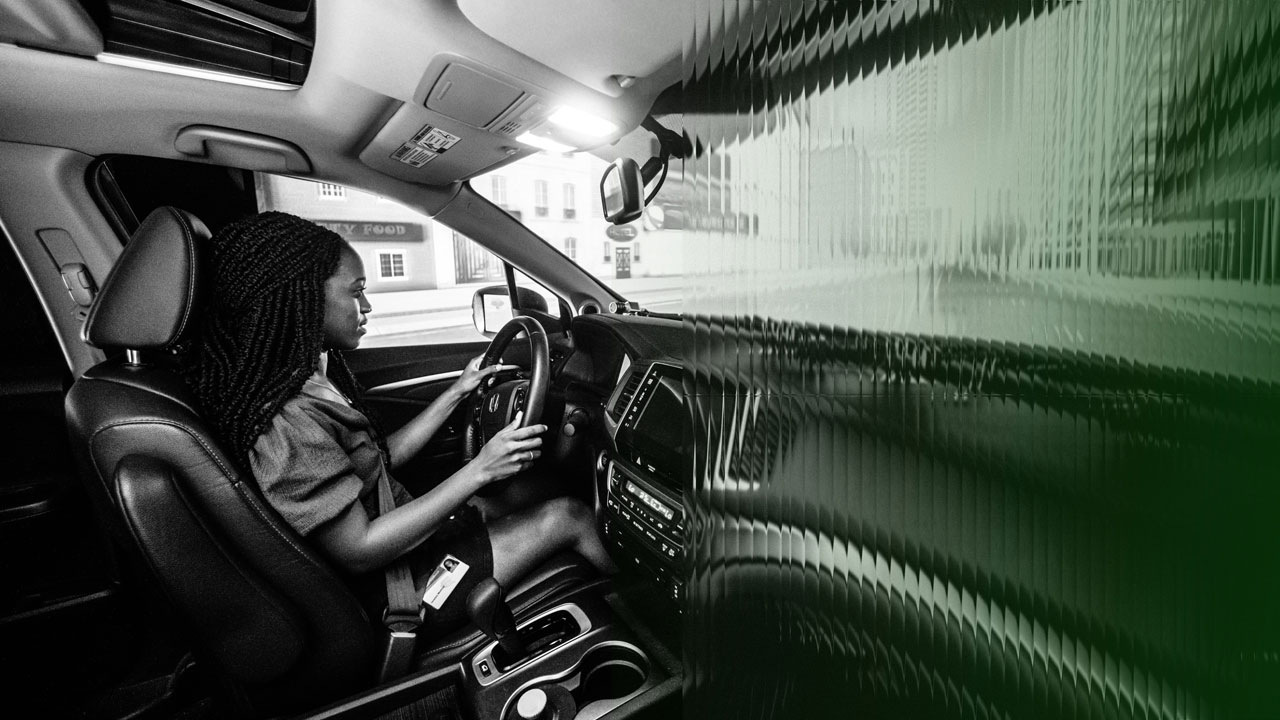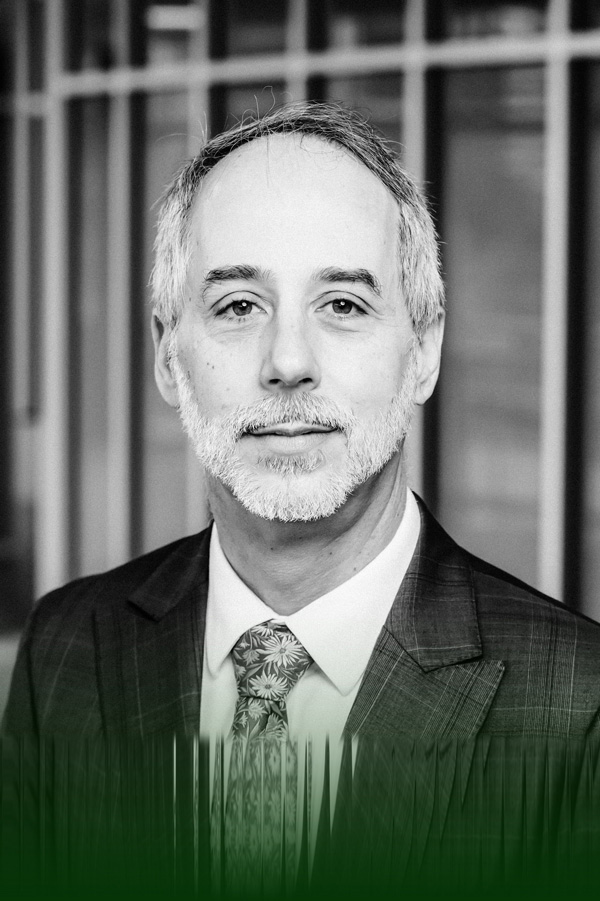
In a former bank on UAB’s campus, a state-of-the-art driving simulator is coming back to life.
The centerpiece is a 2016 Honda Pilot SUV, complete in every way except for its engine and wheels, which have been removed. It rests on a hydraulic platform and is surrounded by a semicircular wall of digital screens stretching from floor to ceiling. Computers and simulation software are hooked up to the vehicle’s steering wheel, accelerator pedal, brakes, rearview mirror and side mirrors. Hit the gas and the vehicle rocks back on its gimbals, pushing you into your seat and mimicking the acceleration effects of a real car. Stomp on the brakes and you are jolted forward. Pass oncoming traffic on the big screen in front of you and it immediately shows up in the rearview mirror. Overtaking cars that start out in the rearview mirror seamlessly appear in the side mirrors and finally pass by out the windshield. Eye-tracking cameras capture where the driver is looking at all times.
This simulator, originally installed for a transportation safety researcher in the Department of Psychology, has remained relatively dormant since the researcher’s lab moved to another university in 2023. But thanks to a grant from UAB’s Strategic Investment Fund, it is set to reopen this year as a campuswide resource, known as the UAB Multi-Disciplinary Driving Simulator Lab.
“Fascinating ideas”
The principal investigator for the project is Jeffrey Holmes, M.D., Ph.D., dean of the School of Engineering. Holmes toured the driving simulator soon after he arrived at UAB in 2020. “It was really cool, interesting work,” he recalled. Over the years, Holmes had connected interested faculty with the lab’s research team. When he realized that the simulator no longer had a funding source to keep it going, “I reached out to a number of people and said, ‘We should all get together and talk about what might be possible,” Holmes said.
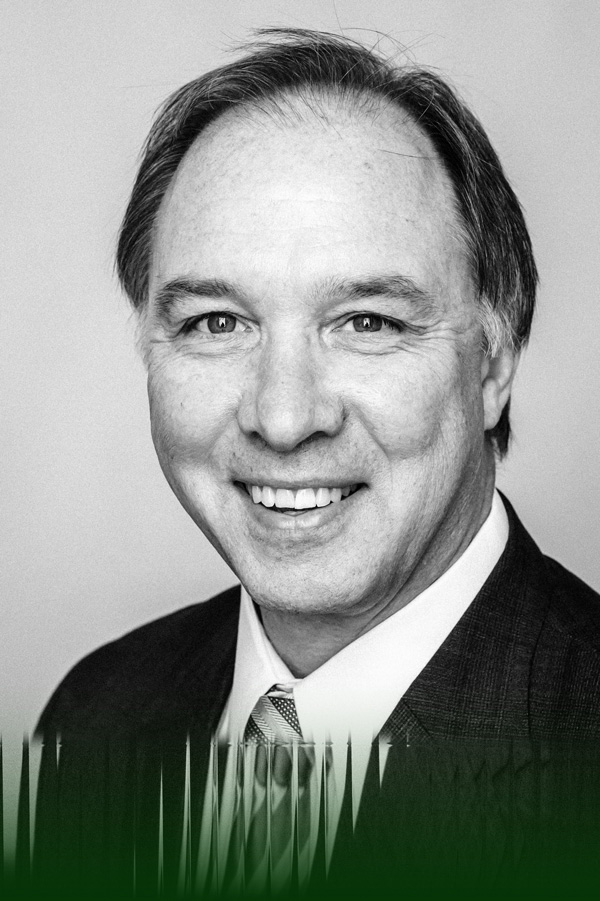
Last fall, Andrew Butler, Ph.D., dean of the School of Health Professions, hosted a group of 20 or so interested parties at the school, and they began to brainstorm ideas on how the driving simulator could be used. “In our discussions, faculty have put forward many fascinating ideas for studies,” Butler said. “Usually, we have to narrow all these ideas down to one, but this is a unique collaborative space that allows multiple investigators from across UAB to explore the many different potentials of driving simulators in both research and clinical care.”
“People have some really interesting questions they want to answer,” Holmes said. “When is it safe for someone with epilepsy to drive? How can you help someone return to driving after a head injury? Can you use this to build better roads?”
Avoiding the ditch
Before he came to UAB, Gavin Jenkins, Ph.D., chair of the Department of Occupational Therapy, ran a center at Mississippi State University dedicated to training drivers with physical and cognitive deficits. He is eager to see if a highly realistic driving simulator could help decide which potential drivers are ready to get behind the wheel and which might end their qualifying test in a ditch on the side of the road — a place Jenkins has ended up more than once.
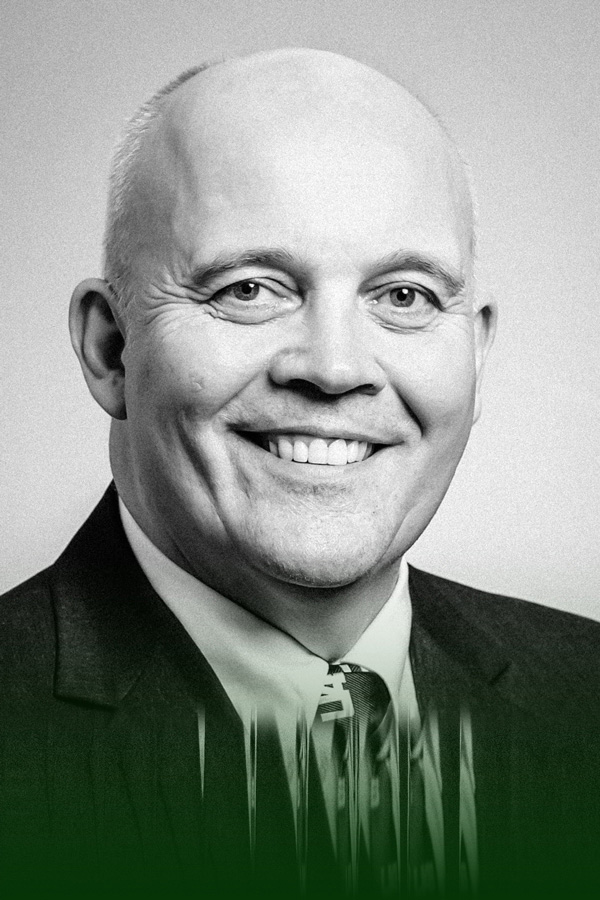
“I had a client, a middle-aged man who had a traumatic brain injury and wanted to return to driving,” Jenkins said. “He passed everything — he did all the paper tests and the limited simulator tests I could do at the time. We got out on the road and he did great, until we came to a stop sign and he went right through it.” Jenkins pointed this out and the client said he must have missed it. Then the same thing happened again. “He had this blindness to stop signs,” Jenkins said. “It was just a deficit somewhere in his vision and we could never overcome it. From a clinical perspective, what I’m excited about is taking a piece of equipment that is not typically used for this function and seeing what we could do with it. How much can a simulator replace the on-road experience? And in what particular conditions can we say, ‘You failed the simulator, we’re not going to go on the road,’ or ‘You failed the simulator, so we’re developing these exercises for you to work on before you go on the road’?”
Because the simulator can be programmed to replicate dangerous road conditions — including bad weather and pedestrians who dart out into traffic — it can give clinicians a better idea of how clients will respond once they are driving alone and in the real world. “On-road tests only happen on quiet roads and in ideal conditions,” Jenkins said. “With a simulator, we can get an idea of how someone would react when things are not so ideal.”
Another idea Jenkins would like to investigate “is a service for older drivers and their families to help families explore whether or not an older adult needs to stop driving or begin to think about stopping driving,” Jenkins said. “Anyone using the service would not only get sound data to support the decision to drive or not but also get to work with an occupational therapist to explore community mobility options if they have to stop driving. It is fine to say people cannot drive, but they still need to get to the store, doctor’s office, etc. An OT can do that with them.”
“A special opportunity”
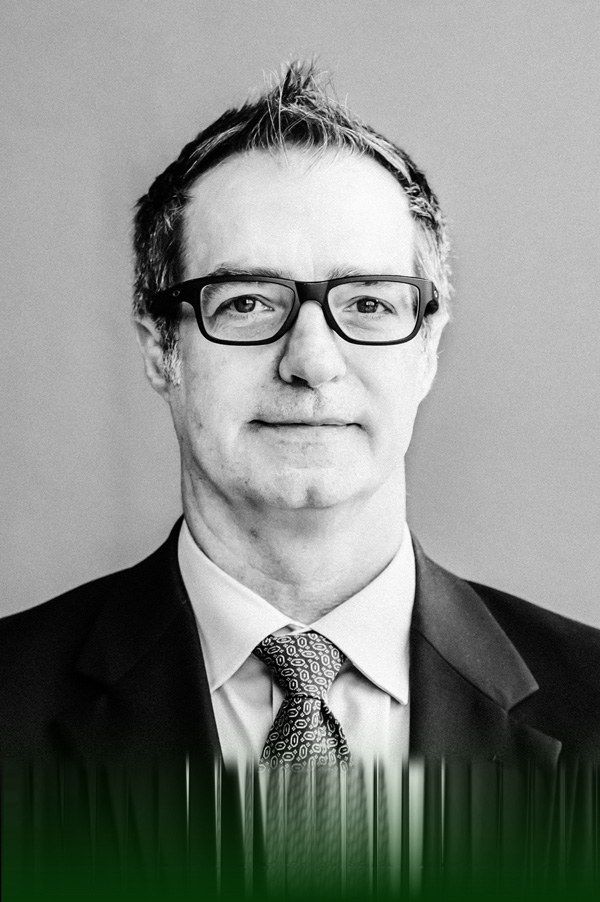
Meanwhile, William “Jamie” Tyler, Ph.D., professor and co-director of UAB’s Center for Neuroengineering and Brain Computer Interfaces, as well as the university’s doctoral program in Neuroengineering, wants to use the driving lab as a testbed for advancing human-machine interfaces.
Tyler has developed several noninvasive methods for modulating brain activity and cognition, including transcranial focused ultrasound for neuromodulation (tFUS) and transcutaneous auricular vagus nerve stimulation (taVNS) devices. His work has been supported by DARPA, the U.S. Army, the U.S. Air Force Research Laboratories, and the National Science Foundation to “advance these platform technologies for enhancing cognition and human-machine interfaces,” Tyler said. His taVNS devices are “presently used by the U.S. Special Operations community to enhance the cognitive performance of remote pilots, as well as to enhance training and learning by modulating neuroplasticity,” he added.
Tyler thinks vagal nerve stimulation could help many different types of drivers avoid accidents, including distracted drivers; those with attention problems, such as people with ADHD and traumatic brain injuries; as well as truck drivers and other heavy road users. He also is installing EEG machines in the Driving Lab to capture the brainwaves of participants while they are behind the wheel. UAB patients with implanted electrodes used in deep brain stimulation, an effective treatment for Parkinson’s disease, could provide an incomparable source of data on what is going on in the brain when someone is driving, Tyler says. “We would like to better understand attention and how people interact with machines,” he said. “This driving simulator is a special opportunity to do that while leveraging neurotechnologies we have developed over the last decade.”

Christopher Henrich, Ph.D., chair of the Department of Psychology, noted that there are a number of faculty in his department with expertise in driving research, including studies dating back at least to the 1990s that have contributed fundamental discoveries about driving in older adults. “But their expertise is not in programming or analyzing the data,” Henrich said. The funding for the UAB Multi-Disciplinary Driving Simulator Lab includes a full-time, onsite expert who can handle the technical details of making the simulator run. Several faculty in psychology are interested in research on increasing driving safety. “And then I also think that the driving simulator is a great tool for simulating the day-to-day cognitive and perceptual demands that people encounter in the real world,” Henrich said. “This would be research that looks at driving as a manipulation to see what impact it has on people’s cognition and behavior, including in neurodiverse populations and patients with psychological disorders.”
Avi Unnikrishnan, Ph.D., chair of the Department of Civil, Environmental and Construction Engineering, sees potential for testing road configurations that encourage drivers to slow down — without pouring millions of dollars’ worth of concrete first. “Simulators make that so much easier,” he said. “This is a perfect way to test new transportation modalities.” The lab also offers a great opportunity to test new driving safety technologies, including such things as radar-based cruise control and lanekeeping assist. “We can have the same participants drive with these devices on and off to test how much they contribute to increased safety,” Unnikrishnan said.
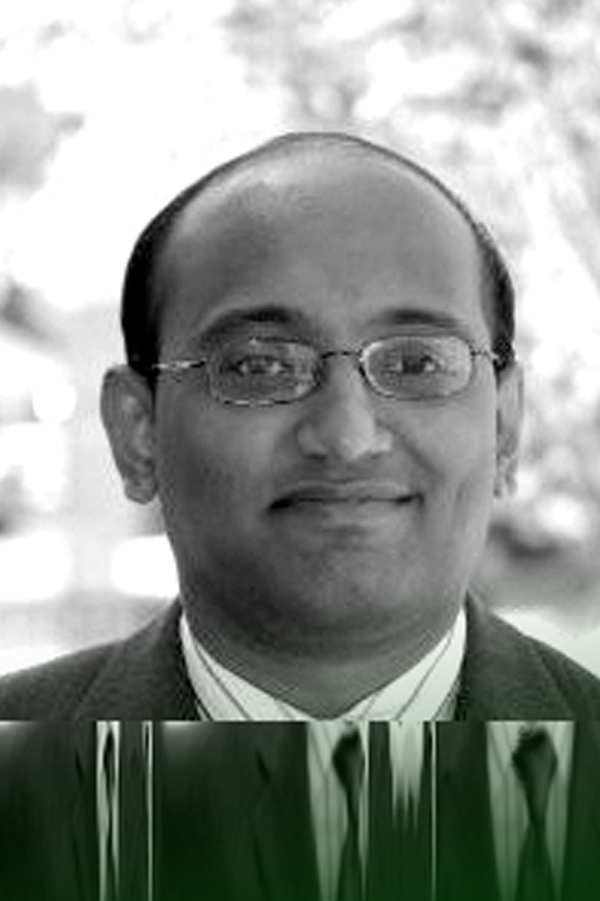
Lab will include desktop simulators, too
In addition to the full-size simulator, the Multi-Disciplinary Driving Simulator Lab is also installing desktop-based simulators, Unnikrishnan says. That will give researchers the opportunity to compare participants’ performance on the full-size simulator versus a much more inexpensive option.
“If you can get good results with a desktop simulator, that scales much better than a room-size simulator like ours,” Holmes said. “Understanding when you need the full one, and when you can use the desktop, is a very interesting question that we can answer in the lab.”
That prospect is intriguing for researchers such as Jennifer Marwitz, M.A., director of Traumatic Brain Injury Research in the Department of Physical Medicine and Rehabilitation in the Heersink School of Medicine. Marwitz is helping to lead a study of a desktop driving simulator as a way to speed the return to driving after traumatic brain injuries.
“After any kind of injury where you hit your head or have a seizure, there is typically a six-month wait before you are allowed to return to driving,” Marwitz said. “But that timeframe is not grounded in evidence, and it is a huge burden for the injured person and their family. They are often cleared to return to work but not cleared to drive. If there are tests that you could do so you don’t have to wait the prescribed six months, that would have a major impact.” The UAB study is comparing participants’ performance on the desktop driving simulator with neuropsychological testing. “And then at six months people will do an on-road evaluation,” Marwitz said. The study aims to assess how well simulated driving performance predicts actual on-road performance. “A second goal of our work would be, if the simulator does show some kind of predictive ability, can we personalize the activities that can be done on the simulator to build a training intervention for people to work on skills?” Marwitz said.
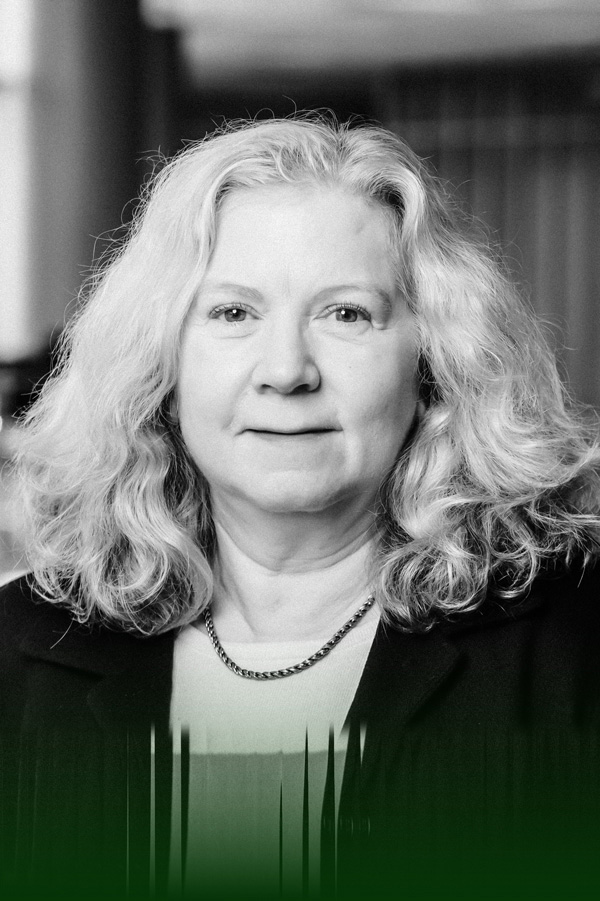
Cross-campus support
The potential applications for clinical and research use of the Multi-Disciplinary Driving Simulator Lab are so widespread that four different schools — the College of Arts and Sciences, Heersink School of Medicine and School of Health Professions, in addition to the School of Engineering — have contributed funds to the project, Holmes said. Two other schools — Optometry and Public Health — submitted letters of support to the Strategic Investment Fund application.
The Strategic Investment Fund support, along with these investments, means the lab will have secure funding for three years, including a dedicated staff member to run the simulator so that researchers can focus on their research questions. “When a researcher uses an MRI, they don’t need to know how to make the MRI work — they need to know how to analyze the results,” Holmes said. “It’s the same idea here.” Strategic Investment Fund support will let the Multi-Disciplinary Driving Simulator Lab offer pilot “grants” of time on the simulator, allowing investigators to try out a new idea or gather preliminary data. Successful projects can then seek external grant funding support.
“Our goal over the next three years is to build capacity and a user base to the point where this could run as a core open to the entire UAB community,” Holmes said.
